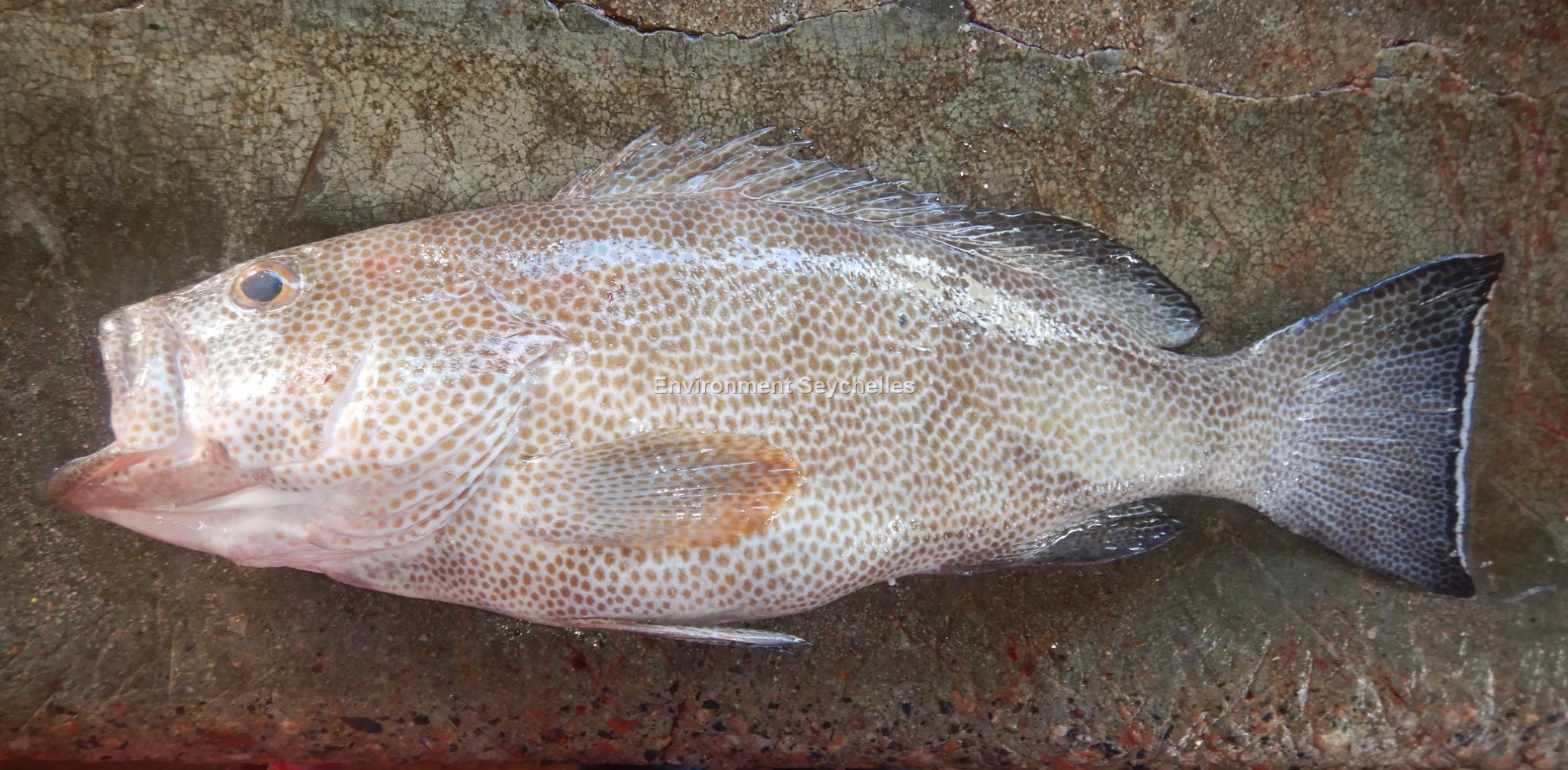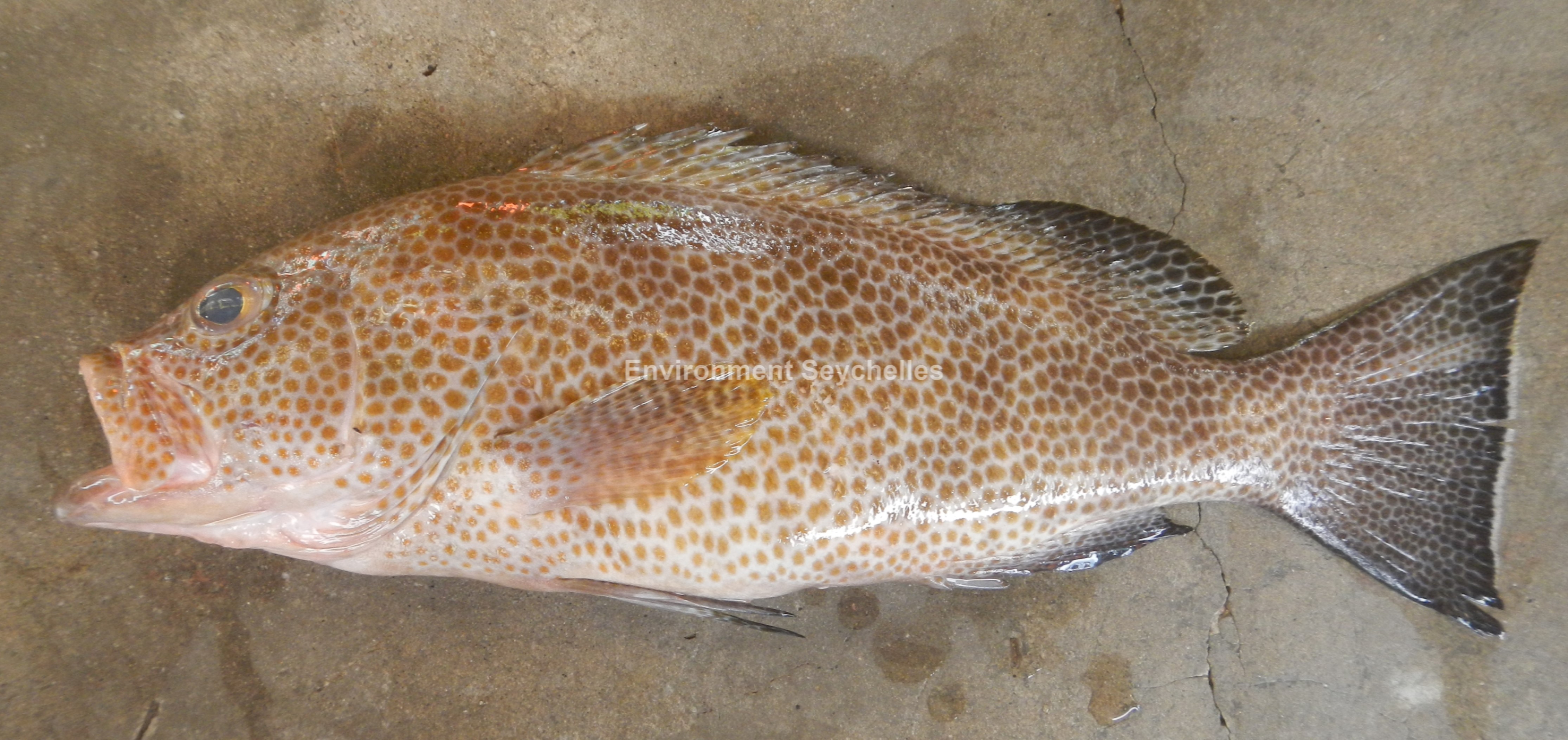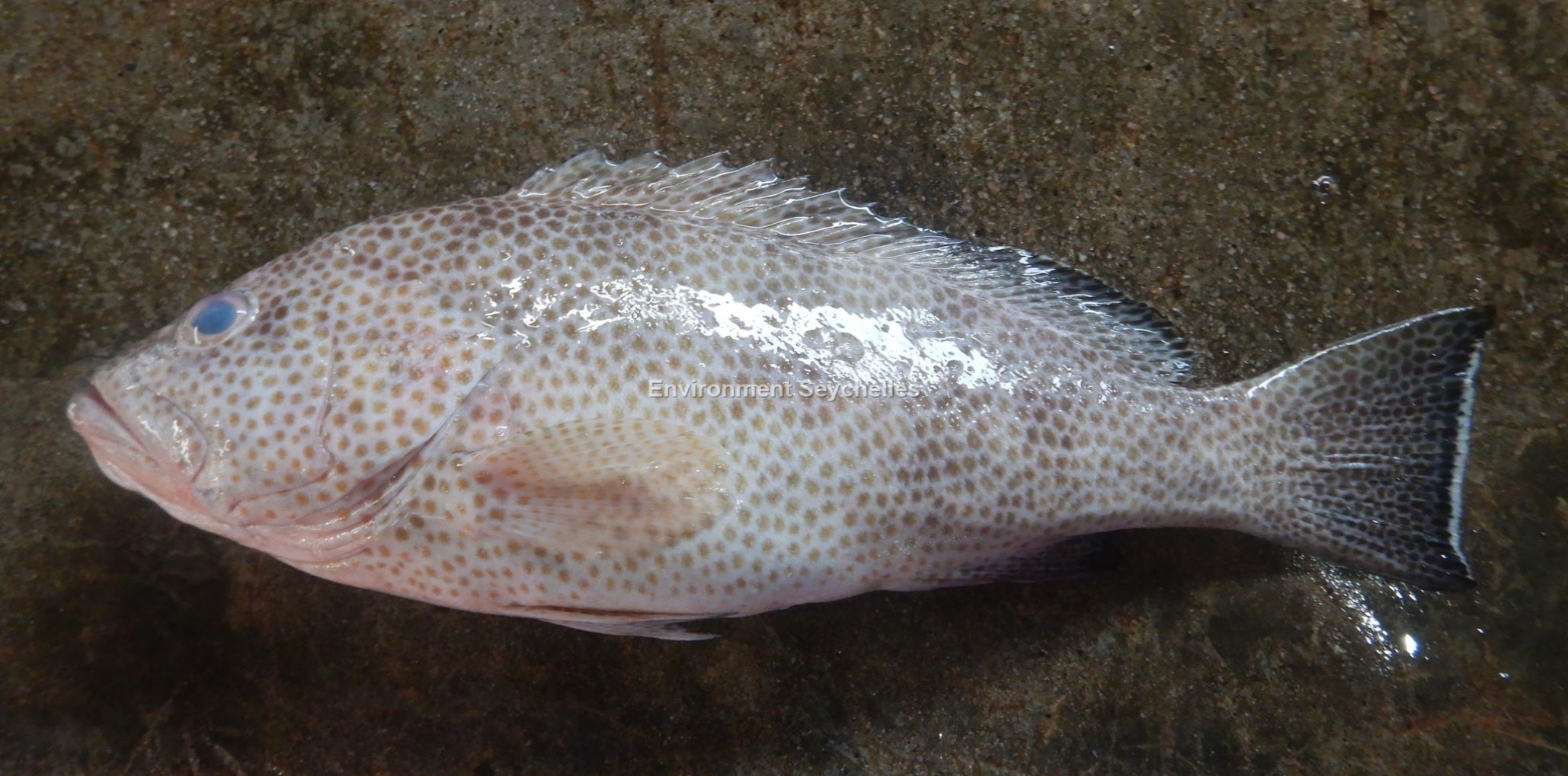Description:
Dorsal spines: 11; Dorsal rays: 16-18; Anal spines: 3; Anal rays: 8.
Small to medium-sized, moderately full-bodied, grouper. Interorbital slightly convex. Lower jaw strongly projecting, with 2-4 rows of teeth mid-laterally,
the inner ones about twice the size of outer teeth. Maxilla reaches about to vertical at rear edge of eye. Preopercle angular, with 4 to 7 enlarged serrae
at angle. Upper edge of operculum straight. Dorsal fin: 3rd or 4th spine longest; interspinous membranes slightly to moderately incised. Anal fin rounded
or angular. Pectoral fins usually slightly longer than pelvic fins. Caudal fin truncate to slightly emarginate.
Colour. Head, body, and fins with small, irregular, close-set dark brown spots. Can assume a transient colour phase of 3-4 rows of large round dark spots
on top of the small-spot pattern. The ground colour forms a pale network. Brown spots are sometimes absent from lower ventral surfaces. Caudal fin usually
with a white line along rear margin. Spots on pectoral fins mainly confined to rays.
Size:
Maturity: Lm 27.0. Range 23-31 cm.
Max length: 80.0 cm TL.
De Moussac (1986) reported female maturity at 23 – 29 cm TL about 31 cm in Seychelles. Protogynous with sex change first occurring at around 34 cm TL, and
the first active males appearing at 37 cm, not all females change sex.
Habitat and Ecology:
Found over a wide range of habitats, seagrass beds and outer reef slopes, also on mud bottoms (depth 4 – 250 m). Feeds on fishes and crustaceans (mainly
stomatopods and crabs). It is common across the Mahe Plateau and surrounding banks, especially at depths from 40 to 60 m. It is more abundant over rough
rubble and coralline areas but has been taken in (experimental) trawls over more sandy areas. In Seychelles the spawning season is protracted, occurring
between November and April and with peaks at the beginning and end of that period. These peak periods correspond to the inter-tropical monsoon months.
Fishery Status:
This species is not protected or subject to fishery regulations. It is caught in the handline and trap fisheries, it is a common and relatively abundant
component of the catch and constitutes the largest single species component of the grouper fishery. There are signs of decline due to fishing effort in
Seychelles. Fennessy et al. (2018) recommended that catches should be monitored carefully and frequently to provide species-specific quantitative
information.
Notes:
E. chlorostigma is closely related and very similar to E. polylepis and E. gabriellae which seem to replace it in the north western Indian Ocean.
These species are characterized by their truncate or emarginate caudal fin, colour pattern of small close-set dark brown spots covering all but ventral
parts of head and body and all of the fins, preopercle subangular with serrae not much enlarged at the angle, gill arches with numerous small platelets,
operculum with a straight upper edge, and 2 rows of teeth on sides of lower jaw. E. gabriellae and E. polylepis, were described in 1991 as new species by
Randall and Heemstra. E. gabriellae has fewer dorsal-fin rays (14 or 15), more elongate body, more slender caudal peduncle and slight differences in
colour pattern (margins of soft dorsal and anal fins and upper and lower margins of caudal fin with white edge; pectoral fins spotted only basally).
E. polylepis has smaller, more numerous scales and a more rounded anal fin in adults.
References:
Bray, D.J. (2018). Epinephelus chlorostigma in Fishes of Australia, accessed 05 Jan 2019, http://fishesofaustralia.net.au/home/species/4513
Craig, M.T. et al (2011). Groupers of the World - a field and market guide. NISC (Pty) Ltd, South Africa. ISBN: 978-1-920033-11-8
De Moussac, G. (1986). Mise en evidence de l’hermaphrodisme protogyne d’Epinephelus chlorostigma (Valenciennes, 1828) aux Seychelles (Pisces, Serranidae).
Cybium, 1986, 10 (3): 249-262.
Fennessy, S. et al. (2018). Epinephelus chlorostigma. The IUCN Red List 2018: http://dx.doi.org/10.2305/IUCN.UK.2018-2.RLTS.T118358386A100463851.en. (07/10/23).
Froese, R. & D. Pauly. Eds. (2023). FishBase. http://www.fishbase.se/summary/5524 (07/10/23).
Heemstra, P.C. & Randall, J.E. (1993). Groupers of the World. Vol. 16 FAO Species Catalogue. FAO Fisheries Synopsis No. 125, Volume 16. FIR/S125 Vol. 16.
Sanders, M.J. et al. (1987). Preliminary assessment for the brown-spotted grouper Epinephelus chlorostigma occurring on the Mahé Plateau (Seychelles).
In: In: M.J. Sanders, P. Sparre and S.C. Venema. (eds), Proceedings of the Workshop on the Assessment of the Fishery Resources in the Southwest Indian
Ocean, pp. 268-277.
Smith, M. & Heemstra, P. (Eds.) (1999). Smiths’ Sea Fishes Edition 6. Springer-Verlag Berlin Heidelberg 10.1007/978-3-642-82858-4
Citation:
Nevill, J.E.G. (2023). Epinephelus chlorostigma, Brownspotted grouper. Seychelles Seatizens. www.seatizens.sc. https://seatizens.sc/species/epinephelus-chlorostigma-valenciennes-1828/



